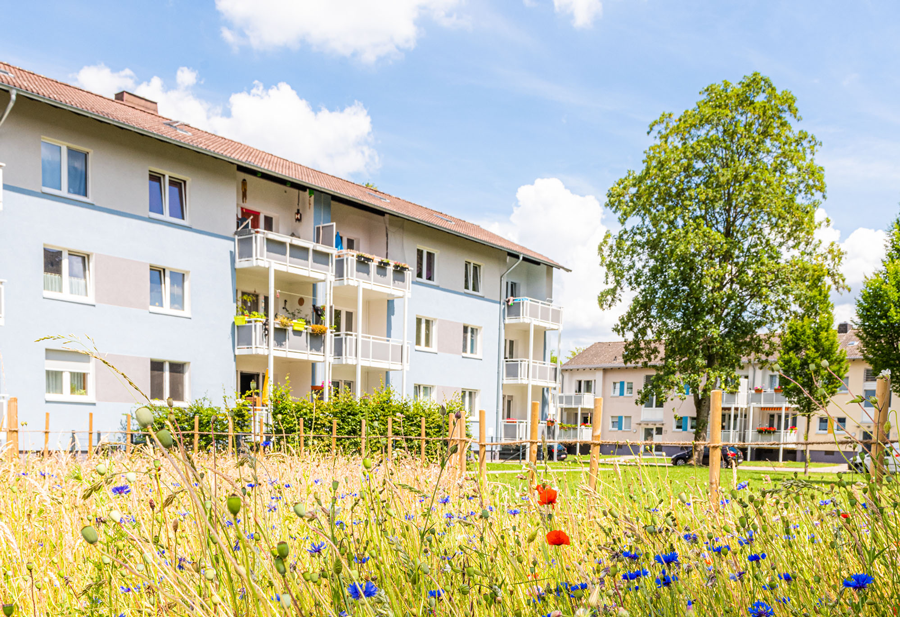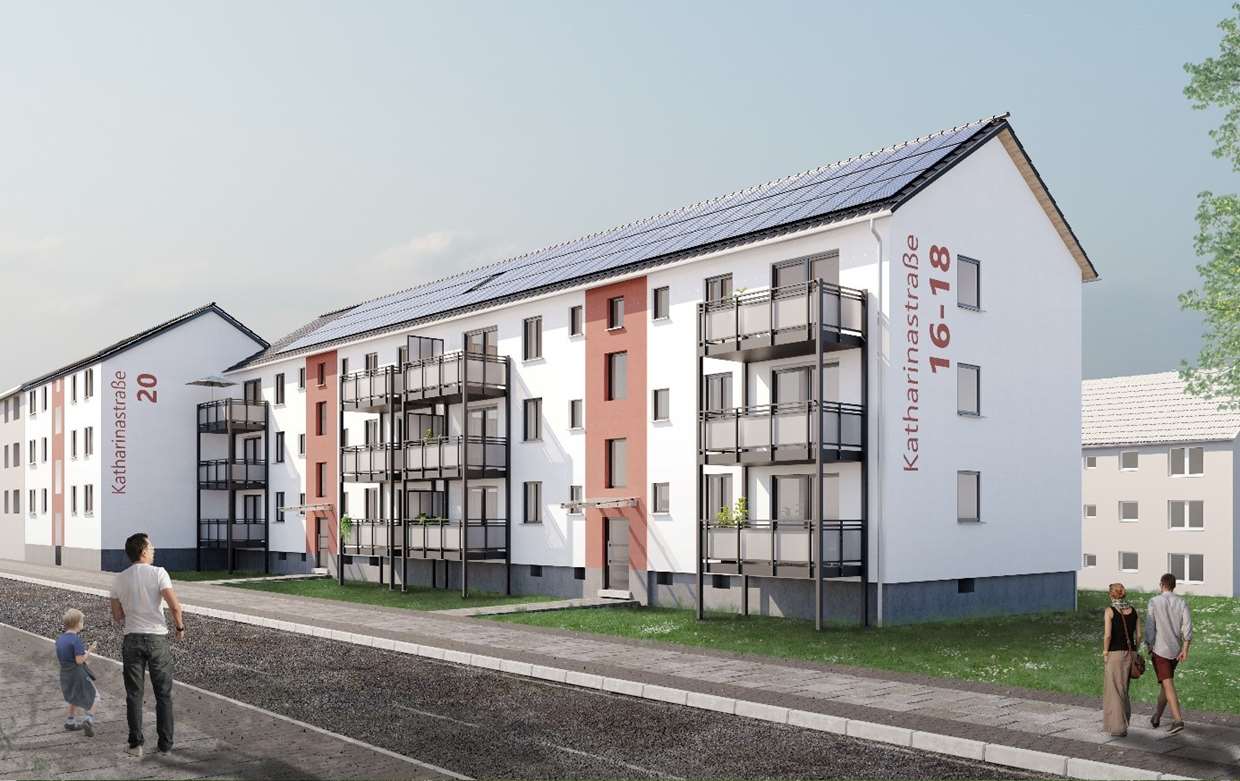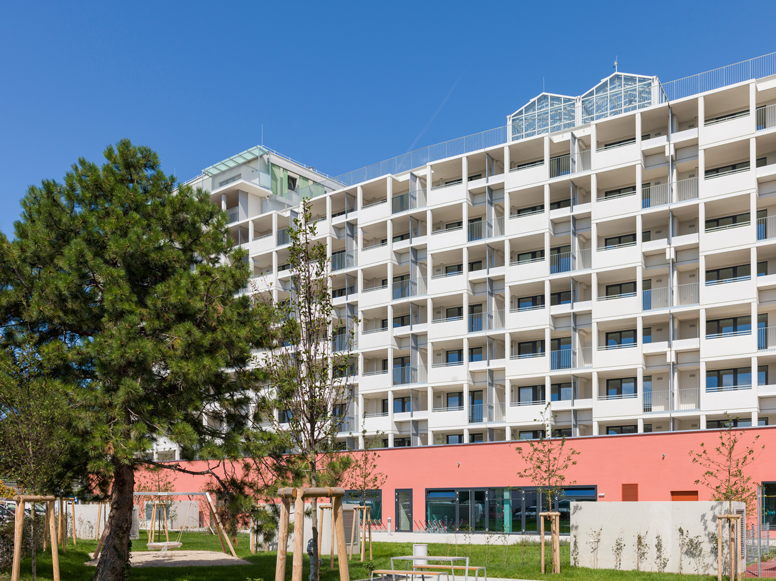Reducing CO2 in the Real Estate Portfolio/Energy-efficient Modernization
GRI
102-11
102-13
103-1
103-2
103-3
302-3
305-1
305-2
305-3
305-4
305-5
Our Approach
Vonovia is committed to making its property portfolio almost completely climate neutral by 2045. Owing to the size of the company, we see ourselves as a key driver of climate action in the housing industry. This means that we can help the sector as a whole make great strides towards achieving the goal of a carbon-neutral building stock. We track our emissions using the recognized Greenhouse Gas Protocol. Most of our emissions are Scope 1 emissions (direct emissions, approx. 45%) and Scope 2 emissions (indirect emissions caused by consumption of district heating and power, approx. 40%) of the properties in our portfolio. The majority of these are in Germany.
In the reporting year, we further developed our climate strategy and redefined our goal. In light of the new Federal Climate Change Act and the sector targets contained therein, we have set the target of achieving a virtually climate-neutral building portfolio by 2045, with carbon intensity of less than 5 kg of CO2 equivalents per m² of rental area. Along the way, we want to reduce our carbon intensity to less than 25 kg CO2e/m² by 2030. This target has been incorporated into our sustainability performance index (SPI), which affects the remuneration of the Management Board. Carbon intensity is the most significant component of the sustainability performance index in terms of its weighting. The targets were developed as part of an interdisciplinary collaboration between various functional areas and with the support of the scientific community (Fraunhofer ISE). They are contingent – not only on a comprehensive improvement of the building portfolio’s energy efficiency through energy efficiency modernization, and an increased share of renewable energies in our neighborhoods – but also on a profound transformation of the energy sector. As such, the provision of sufficient volumes of carbon-free district heating and electricity by the energy sector, coupled with a more rapid phase-out of coal, as described in the Coalition Agreement, are fundamental prerequisites for a climate-neutral buildings sector.
CO2e Emissions – Portfolio (in Germany)
Carbon Intensity – Portfolio (in Germany)
Vonovia Climate Path: Portfolio Decarbonization Strategy
With respect to the attainment of our climate target and the targets of the housing sector as a whole, the right subsidy instruments and the removal of legal hurdles remain decisive. After all, we believe that ambitious, long-term partnerships and above all a different political framework are needed in addition to commitments and investments in order for climate-neutral housing to become a reality and stay affordable. Our commitment to modeling and developing sustainable solutions to mitigate climate change demonstrates that we are operating in a field that is undergoing rapid regulatory change while also attempting to meet the needs of a wide variety of stakeholders and remain profitable.
For this reason, our climate path takes social and economic targets into consideration in addition to the environment. Following the initial definition of the target in 2020, concrete implementation work continued in the reporting year. Energy-efficient refurbishments are a key element of our climate path. A specially developed decarbonization tool makes it possible to break down the Group target at the level of regions and neighborhoods – and identify nuanced solutions (see project box “The Vonovia Decarbonization Tool – C02 in Focus“). We make improvements to the tool on a continuous basis in order to identify the optimal balance between carbon targets and our performance as a business. This provides us with the best possible basis for making decisions as a company.
Here, too, the focus lies on the urban quarter, particularly in the context of the energy revolution. Many integrated solutions for energy provision with renewable energies and carbon reduction can only be implemented in a technically feasible and economically viable way within larger neighborhoods. The innovation clause of the German Buildings Energy Act (GEG), for example, is only applicable to neighborhoods. These circumstances have increased our focus on neighborhoods and underline the importance of taking a holistic approach.
Organizational Focus
The Portfolio Management unit reports to the Chief Rental Officer (CRO) and is responsible for the general planning and coordination of modernization measures in the portfolio. Within the unit, the Climate-neutral Portfolio/Strategic Projects department is tasked with developing solutions for bringing our property portfolio and the corresponding investment strategy in line with our climate action goals. It is also supported by the Sustainability/Strategy unit, which reports to the Chief Executive Officer (CEO). The properties/neighborhoods to be modernized are selected in a targeted manner in cooperation with the regions, and the optimal degree of modernization for each building is defined. Investments for modernization measures are approved by the full Management Board. Compliance rules require the involvement of the Supervisory Board in some cases. The Investment Management department manages the budget for modernizing the portfolio. Vonovia Technical Service (VTS) is responsible for planning and execution.
Energy efficiency modernization measures in Austria are, like overall business operations in Austria, the responsibility of the Chief Development Officer (CDO) under the BUWOG umbrella, where they are led by the Real Estate Management division.
Division heads are responsible for planning investments in modernization work at Victoriahem in Sweden. This process is integrated into the annual budget planning process and is updated in line with the company’s business forecast. The investment plan is reviewed by regional managers, the Head of the Energy and Environment Department, business controllers and project managers to make sure that the estimated savings and costs are accurate before the plan is approved by the CFO, COO and CEO.
Objectives & Measures
In line with our holistic approach, our measures focus more on neighborhoods than our individual rental units (see Society and Contribution to Urban Development). In Germany, we use public funding programs to keep modernization work affordable for our tenants. The revised terms of the federal funding program for efficient buildings (BEG) include some interesting options in this respect, such as direct subsidies for modernization work. Serial refurbishment is another approach that will limit the costs of modernization. Serial refurbishment is defined as the process of using pre-fabricated facade and roof elements to refurbish existing buildings with the aim of making them more energy-efficient.
The refurbishment rate in Germany in the reporting year was 2.3%, compared to 2.9% in the previous year. The drop is, among other things, attributable to the new conditions for subsidies and the adjustments to the internal management system to focus on the neighborhood level, which requires more complex and therefore longer planning. In the year ahead, it is expected that the refurbishment rate will once again exceed 2%.
Alongside optimization of building envelopes, the switch to lower-carbon energy sources also stands at the forefront. As part of our quest to achieve a virtually climate-neutral housing stock in 2045, Vonovia is aiming to have reduced the carbon intensity of its housing stock in Germany to below 25 kg CO2e/m2 by 2030. In the reporting year, carbon intensity stood at 38.4 kg CO2e/m2 and was therefore approx. 2.8% lower than in the previous year (2020: 39.5 kg CO2e/m2). The metric comprises Scope 1 and Scope 2 emissions across our entire portfolio, and part of the Scope 3 emissions (fuel- and energy-related emissions upstream and commodities leased downstream). As such, the goal set for the reporting year of a reduction of at least 2% was achieved. In particular, the reduction is based on energy efficiency modernization and an improvement in the carbon intensity of district heating. For further information, please refer to Environmental Key Figures.
PERFORMANCE METRIC 2021
Notes on the Calculation of Carbon Emission
- In accordance with GHG Protocol and IW.2050/GdW Arbeitshilfe 85
- Total property portfolio, including listed buildings
- Based on energy certificates, in relation to rental area (not total area)
- GEMIS 5.0 carbon factors used
- Specific carbon factors for district heating in some cases
- Including energy-related upstream emissions (Scope 3)
As part of the continuous enhancement of our calculation of carbon emissions, we will make a modification in the calculation of carbon emissions for district heating starting in the 2022 fiscal year, where we will use the Carnot allocation method in the future. This has the advantage that the allocation of carbon emissions between electricity and district heating is based on purely physical considerations, meaning that we can structure our long-term climate strategy and corresponding innovations in a way that is robust against regulatory changes in the long term. Had this method been applied to the building portfolio in the 2021 reporting year, it would have resulted in a theoretical carbon intensity of 35.6 kg CO2e/m².
Vonovia Climate Path: Portfolio Decarbonization Strategy
Focus of energy-efficient modernization measures
The energy-efficient modernization measures focus on heat insulation for facades, basement ceilings and attics, the replacement of windows and the installation of new heating boilers. We modernized around 8,200 units in the reporting year, not including heating system upgrades. That equates to a refurbishment rate of 2.3% in Germany for 2021. The year-on-year drop (2020: 2.9%) is, among other things, attributable to the new conditions for subsidies and the adjustments to the internal management system to focus on the neighborhood level, which requires more complex and therefore longer planning. In terms of heating modernization, we focus on the use of hybrid solutions, heat pumps and wood pellets. We are also investigating the potential of connecting to new and existing district heating networks in Germany. We replaced boilers in around 4,100 units in the reporting year. By the end of 2022, we also aim to have replaced all existing oil heating systems in existing buildings in Germany.
(in Germany, excl. heating system upgrades)
When carrying out energy efficiency building refurbishments, we need to consider both the strain on the tenants/residents concerned and the rising costs. Vonovia is committed to using numerous (academically supported) cooperation projects and integrated approaches to find innovative and cost-efficient, effective solutions for energy efficiency and a climate-neutral housing stock. One example of this sort of approach is the Energiesprong initiative, a serial refurbishment concept that uses standardized and pre-fabricated construction components to minimize refurbishment times and maximize residential comfort on the basis of an innovative financing model. The aim of the initiative is to conduct refurbishments to bring buildings to net zero, meaning that they generate as much energy in a year as they consume. The Energiesprong principle is currently being piloted at 24 units in Bochum and is also to be rolled out further within the portfolio at a future stage (see project box “Energiesprong: Serial ‘Green‘ Refurbishment”). Vonovia is also taking part in projects to optimize the operational management of heating systems and the interaction between, for example, system technology, user behavior and structural measures, so as to deliver further cost minimization solutions. One of these is the interdisciplinary research project BaltBest headed up by the EBZ Business School. The purpose of this three-year project was to uncover new ways to reduce the costs involved in heating properties. This was the largest research project of its kind in Germany to date, and identified a number of improvements that could cut heating costs by up to 20% per property. These include optimizing operational management, replacing boilers to save energy, improving communication with tenants about energy consumption and large-scale data gathering.
We organize events with various stakeholders on a regular basis to provide a platform for dialogue. Following on from our Outlook for Climate-neutral Housing conference in 2020, we held climate discussions in the form of digital lunches for our stakeholders in 2021. Due to their popularity, we have a number of sustainable conference formats planned for 2022, such as a conference on the Outlook for Climate-neutral Construction.
Average Energy Intensity in the Portfolio* (in Germany)
We took part in a number of events held by Initiative Wohnen.2050 (IW.2050) in 2021, of which we are a founding member. The initiative focuses on learning from each other and fostering dialogue, with the ultimate aim of the entire housing industry having a shared understanding of the importance of climate change mitigation and taking a unified approach to combating climate change. The initiative uses a variety of guidelines, tools and dialogue formats on strategic and technical issues for this purpose.
Wohnen.2050
In Austria, BUWOG has been a partner of the “klimaaktiv pakt” climate protection initiative launched by the Austrian Federal Ministry for Climate Action, Environment, Energy, Mobility, Innovation and Technology since 2011. Following completion of the first stage of the initiative in 2020, BUWOG has set a new goal as part of “klimaaktiv Pakt2030”, the aim being to achieve a reduction in emissions of 55% by 2030, compared to the base year of 2005 (see project box “Leading the Way: BUWOG Signs klimaaktiv Pakt2030“). Modernization and improvements to our existing portfolio will account for the majority of carbon reductions. Insulation refurbishments, improvements in the efficiency of heating systems and switching to more eco-friendly energy sources have the most important role to play. BUWOG has also had a certified energy management system that is consistent with ISO 50001 standards in place in Austria since 2013/14 and in Germany since 2018. The system is a tool used voluntarily to systematically manage energy performance and improve it continuously. The corresponding establishment of processes that reflect this policy in the company and clearly defined objectives serve to increase energy efficiency, reduce energy consumption and cut energy costs.
Energy Efficiency Standards in the Portfolio (Germany) – 34.9% in Efficiency Class C or Better*
In Sweden, virtually all existing Victoriahem buildings are supplied with district heating, the generation of which already produces extremely low carbon emissions. Therefore, the road to climate neutrality will primarily be shaped by further decarbonization of heating supply, coupled with ongoing improvements in energy efficiency.





